A small oblong Saxon building with an apse at the altar or east end has stood on this site from about
the middle of the 10th century. Conclusive evidence of its being dated within the Saxon period has been
presented by several researchers and writers.
The building stone is 'clench' and imported limestone. The latter material was available nearby and could
have been conveyed by 'Roman' roads or river. The local stone mason and carpenter would have been employed
on the job, perhaps with a more experienced overseer.
During the next three centuries the church of St. Mary was improved and enlarged as the needs of the
community arose. The present south aisle was built in the twelfth century, and the thirteenth century saw
the addition of a north aisle and the chancel rebuilt and squared at the east end. A typical Hertfordshire
tower of three stages was added in the fourteenth century with a three-light decorated window at its west
end.In the fifteenth century the porch and priest's chamber above it (parvise) was added at right angles
to the south side with an opening into the south aisle. Inside the porch, on either side, are stone
benches set into the walls; above them are mullioned windows once enclosed with coloured glass.
The exterior of the building took its present form in the late nineteenth century, with buttresses added
to both the north east and south east corners of the aisles. The roof has a double pitch.
The opening from the south porch into the church is Norman with pilgrim marks by it. The original oak door
was restored in 1882.
On entering the south aisle one is faced by a Saxon wall. This is the oldest part of the church, 950-1000
A.D. Two semi-circular arches with square piers are cut into this wall, the western-most one showing
Romanesque work at the springing. High above (12 feet from the floor) on the west arch is a mutilated
Saxon rood or cross, carved in chalk, of a figure of Christ 5 feet tall and robed. The head is in
sharp relief in the Christus Dominus position. The features are prominent and a moustache covers the
upper lip. The Alb (robe) is girded at the waist by a cord or belt with a cross on the front. The ankles
are clearly visible but the feet and arms are missing. Possibly when the beams for the roof were raised
and the arch lifted between the 12th and 14th centuries, mutilation took place. The veiled crucifix was
not used after the 12th century, the nude figure taking its place. Only two similar Saxon figures are
known to exist in the country.
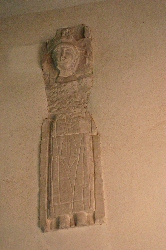
Lower down on the pillar are scratch marks or graffiti. To the west of the south door a Norman window has
been blocked up and a door leads up some circular stone steps to the priest's room.
Near this door stands the octagonal Font, Early English fourteenth century.
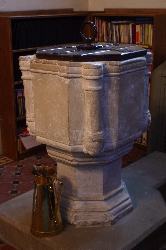
In a niche in the south wall of the aisle lies an effigy in Purbeck Marble of a Knight Templar in chain mail with visor down and legs crossed, probably William de Lanvalei II, early thirteenth century. Beyond, to the east, yet another door opens to some steps to the former rood loft.
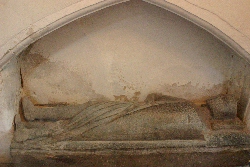
In 1643 Parliament sent Commissioners into every parish to order the church wardens to remove and destroy all images. In the north aisle of St. Mary's high in the rafters, two carved figures survived. The roof of both nave and aisle have not been altered since first erected in the fifteenth century.
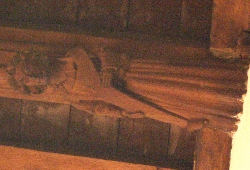
The tower houses a peal of six bells, the earliest dated 1696. Three were cast in 1713. A fifth bell was
added in 1833 and the last, a treble, in 1925. A carillon of five bells is worked from a box on the south
wall in the tower.
In the nave floor, in front of the tower arch, is a brass to Edward Humberston and his wife, 1583. This is
a Palimpsest, i.e. a re-used brass, turned over. The original was a memorial to John Lovekyn, a stock
fishmonger and four times Lord Mayor of London who died in 1368.
On the floor in the north aisle is a small brass of a man and wife of the Humberston family, fifteenth
century, and a separate inscription only, to William Bramfielde, 1596.
In the body of the church the south wall is Saxo-Norman with two un-moulded arches,
but the north arcade has three bays. The clerestory and both aisle walls are of later Perpendicular work,
fifteenth century. The Elizabethan octagonal oak pulpit is on the south side of the nave. Its sunk panels
correspond with the lights of the clerestory windows.
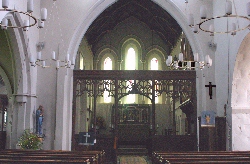
On the south wall of the nave is a monument to Giles Humberston and his wife, 1627.
At the entrance to the chancel lies 'the gem of the church', the repaired once magnificent screen. It is
of fifteenth century work, oak, 12 feet high and was once highly coloured and gilt. The lower panels
are traceries, while above is a wealth of open pierced work of excellent design and enrichment, and shows
much delicate treatment to the minutest detail.
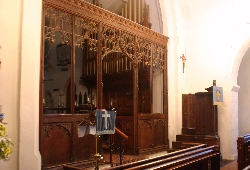
The chancel was partially rebuilt in 1878. The present Early English thirteenth century piscine (basin)
and sedilia (seats for officiating clergy) were re-opened after being walled up with plaster at the time
of the Reformation. They were unfortunately in bad condition, the hood mouldings having been
hacked away. The altar is seventeenth century and the Reredos was presented in memory of the Rev. H.J.
Philpotts (Rector 1889-1913) in 1926. The rails at the altar were introduced in the time of Archbishop
Laud. The present rails are replicas.
The east window of the chancel once had the King's Arms in the middle, while on the right were the Arms of
Gorsuch, with a Crest, a Coronet and a demi-lion (lost during the restoration in 1882). On the left side
were the Arms of the Mercer's Company. The window now houses three stained glass windows, memorials to the
Cotton-Browne family of Walkern Hall, as are those of the north aisle windows. The north light in the
chancel as a figure of St. Mary inserted in 1882.
In the middle of the chancel floor were brasses, figures of a man and woman and their six sons and six
daughters. The inscription is to William Chapman and his wife Anne and their children, 1621 . This has now
been set into the south wall behind the choir stalls.
Above the piscine and sedilia, and high in a niche, is a monument to Daniel and his wife Alice Gorsuch. They
are seen kneeling upon cushions facing one another at a desk with an open book upon it. The epitaph above
the memorial reads:
"Daniel Gorsnor Citizen & Mercer Of London In Ye Month of July 1638 Cavsed Ys Tombe To Be Made For Himself & His Wife Alice By Whom He Had Three Children Iohn Katherine & Mary His Age Being Yn 69 Years 6 Monthes And Odd Dayes, Who Died The Eighth Daye of October Ao DO 1638."
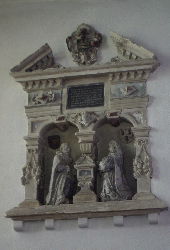
Dr. Benjamin Heath, Rector, 1781-1817, presented the church with its plate of that period - a silver
chalice, patter and alms dish.
In 1842 some renovations and alterations had taken place, the seating in the nave having been altered, the
font probably moved to its present position, from in front of the north door. The fourteenth century chancel
arch was opened up above the screen. At the time the Ten Commandments were inscribed on slate above it and
this came away.
In 1879 when the Rev. James Camper Wright Jr. came to the parish he found the church in desperate need of
repair. So he raised funds and set about the restoration of the fabric and further enlargement.
The present Lady Chapel was added on the north side, but was used as a private pew by the Cotton-Browne
family of Walkern Hall until the 1930's. It is divided from the north aisle by a pierced oak screen with
a hinged door and has its own entrance on the north wall. The screen has recently been glazed.
The north windows are in memory of Miss Georgina Cotton-Browne and were placed in the late 1940's. The east
window above the chapel altar has clear glass and is in memory of Vera Banks, 1976.
The vestry on the southern side of the chancel is a continuation of the south aisle beyond the door to the
rood loft. It acts as a robing room for priest and choir, and partly houses the present organ and pipes. A
brass is set into the wall here to Richard Humberston, 1581, part of the palimpsest in the nave. On the
reverse side the inscription reads:
"The Fair Flesh of John Lovekyn is given for food for the worms."
Another brass is to John, 1590.
In 1882 the church was closed for seven months during which restoration work was done. At the time the
seating was again rearranged, the two tier pews in the north aisle being removed and the present oak
pews (a copy of those at Aston Church) fitted. All the windows, including the clerestory, were re-glazed
in cathedral glass.
A barrel organ was in use in the church, paid for by subscription from the parishioners in the 1840's. In
1870 a new Walker organ was installed. It was electrified during the present century and in 1973 was fully
restored, an extra stop being added - the gift of a member of the Parish.
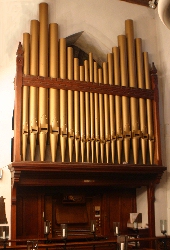
The clock in the tower, is by William Potts, 1906. In addition to its strike it sounds the quarters with
the unusual Gregory chimes.
In the churchyard, to the east of the porch, stands a singular tombstone in memory of Sussanah Lewis. Of
early Georgian date this is in the shape of a candelabrums on four scrolled feet.
Registers date from 1538.
References:
T.P. Smith: The Anglo-Saxon Churches of Hertfordshire.
S. B. Chittenden
J. E. Cussans: History of Hertfordshire.
Compiled by S. Esme Overman.